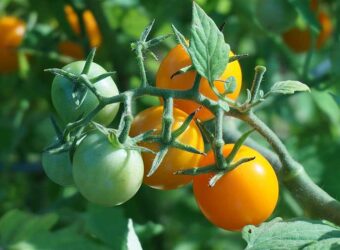Finding a problem with your tomatoes can be frustrating. Some problems are easy to solve, while others mean you need to destroy the plant. This guide will help you diagnose white spots on your tomato leaves.
Top 6 Reasons for White Spots on Tomato Leaves
There are several problems that cause white spots on leaves. The white spots can appear at any growth stage, from seedlings to after transplant to mature plants. These are the most common ones.
Late Blight (Phytophthora infestans)
Late blight is caused by the same pathogen that caused the Irish potato famine. This pathogen infects potatoes, tomatoes, and other plants in the deadly nightshade family. The first sign of the blight is water-soaked lesions on the leaves, which may have a lighter halo around them. On the underside of the leaf, the lesions have a white furry growth on them. Lesions can be found anywhere on the plant, but tend to be on the upper, newer leaves. The lesions will spread, turning the leaf brown and killing it.
Septoria Leaf Spot (Septoria lycopersici)
Septoria leaf spot causes circular lesions that are tan to gray. The lesions appear on the stem and lower leaves first, then spread to the top of the plant. These lesions can spread to the entire leaf, killing it.
Powdery Mildew
Powdery mildew causes a white powder that grows on leaves and keeps the sunlight from reaching them. The leaves can die if they are covered by the mildew. In addition, powdery mildew reduces the yield of tomatoes, and the fruits do not taste as good as fruit from tomato plants without powdery mildew. Unlike other mildews, powdery mildews can spread on dry leaves during relatively low humidity.
Herbicide Injury
Glyphosate, an ingredient in RoundUp®, causes yellowish-white spots on the base of the tomato leaf.
Pest Eggs
White spots, especially on the underside of the leaf, may be pest eggs. They may be single or a whole lot of them may be together.
Sun Damage
When leaves get too much sun, especially when they are wet, white sunburn spots appear on the leaves. The center may be gone, as the water magnifies the sun’s rays and burns the leaf.
Read our article for how much sun a tomato plant needs.
How Do I Fix The White Spots On My Tomato Leaves?
Because white spots on tomato leaves have multiple causes, there is not one fix to remove them. Here are the best ways to treat each type of white spot.
Late Blight, Septoria Leaf Spot, And Powdery Mildew
A fungicide containing copper will treat light blight, Septoria leaf spot, and powdery mildew. Most copper fungicides are allowed in organic gardening. Because copper can be toxic when handled, there is not really a home remedy for these white spots on your tomato leaves. Start treating at the first sign of the disease and treat weekly until the disease is gone. With powdery mildew, treatment needs to continue until the crop is harvested, as it is spread by wind and will reoccur.
Herbicide Injury
Once the tomato leaves are exposed to glyphosate, there is really nothing you can do to treat them. Water them well and see if the tomato vines are able to recover. If only a few leaves are damaged, you can remove them from the plant.
Sun Damage
Once sun damage has occurred, there is nothing you can do to fix it. If the leaf is badly damaged, remove it from the plant.
Pest Eggs
You can crush pest eggs on the leaves with your hand or a stick. Crushing the eggs will keep them from hatching into pests that will eat your tomato plants.
How Do I Prevent White Spots On My Tomato Leaves?
Preventing white spots on tomato leaves is much easier than treating them. Following the suggestions mentioned here will not only help prevent white spots on your tomato leaves but also help prevent other problems.
- Never get the stem and leaves wet during watering. Wet leaves are more vulnerable to diseases and sunburn. Water at the root zone with drip irrigation, a soaker hose, or by pouring water directly on the ground.
- Be careful when using herbicides. When they drift in the wind, they can kill or injure non-target plants.
- Practice good sanitation for your garden. Remove dead and dying plants and leaves at the end of each season. Till the earth under after the fall garden is done. This prevents pests from overwintering in the mulch and soil.
- Keep weeds out of the garden. They harbor pests and steal nutrients, water, and sunlight from your tomatoes.
- Plant varieties of tomatoes that are resistant to the diseases in your area. If you want to grow heirloom varieties that are not resistant to those diseases, consider using resistant rootstock and grafting your tomatoes.
- Buy only certified disease-free seeds and tomato plants. Don’t introduce diseases into your garden.
- Rotate your crops, and do not plant tomatoes where tomatoes, potatoes, or other deadly nightshade plants have grown for three years.
- Leave adequate space between your tomato plants. Determinate tomatoes need two feet between them. Indeterminate tomatoes need three feet of space between them. Rows should be three feet apart. Read here for more details on the difference between these 2 types of tomatoes.
- Fertilize properly. Do a soil test and follow the fertilizer recommendations. When fertilizing during the season, use a fertilizer formulated for tomatoes. Start fertilizing when the plant blooms and follow the directions on the label.
- Keep the soil evenly moist. Large fluctuations in soil moisture can cause blossom end rot and other problems.
- Remember that healthy plants are less susceptible to diseases and pests.
In conclusion, the diseases that cause white spots can be controlled with copper fungicides. Herbicide injury and sunburn can be prevented by being careful. Pest eggs can be crushed to get rid of the pests inside. The best way to combat diseases and pests is to keep your tomatoes healthy.
Check out our guide on how to grow tomatoes in detail here.






